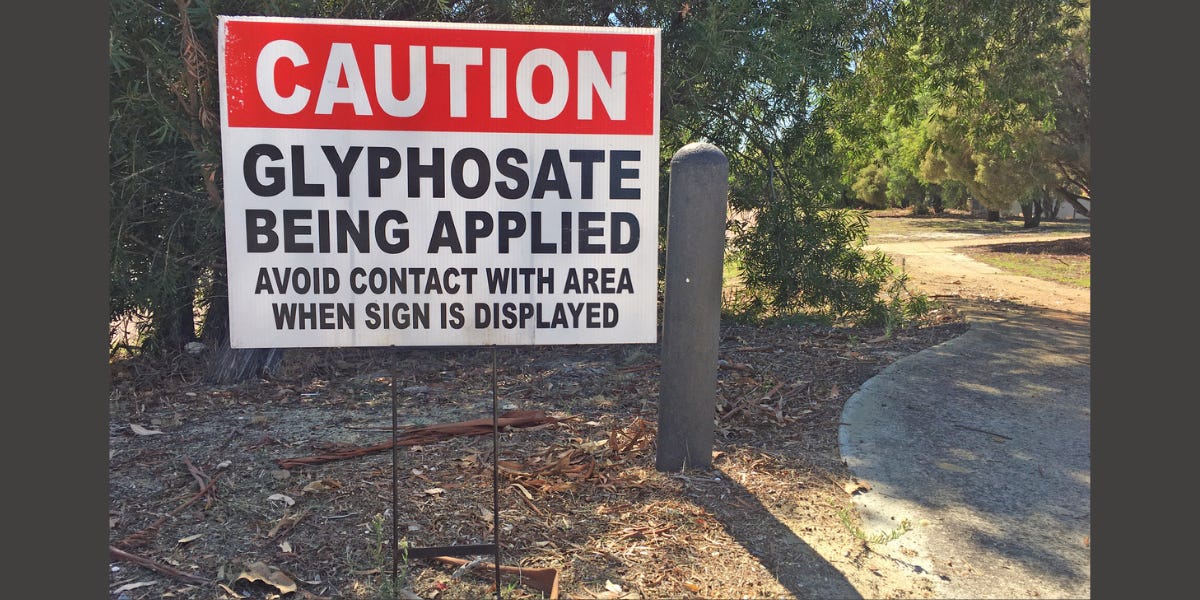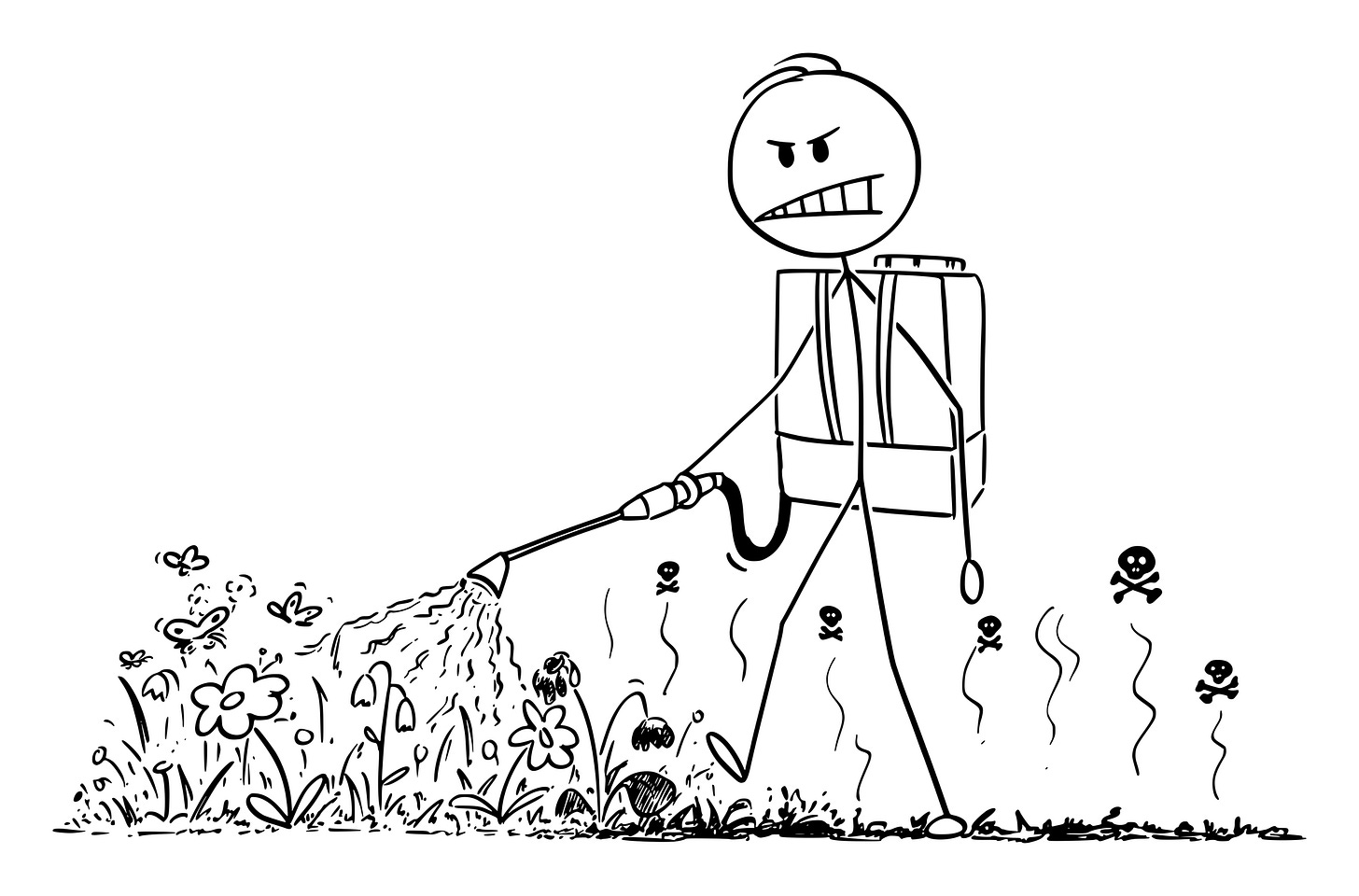Hidden Glyphosate in Your Food: Part One - How to Determine What's Safe For Consumption
By Megan Silcott
EDITOR’S SUMMARY: Making sense of the use of glyphosate in our food supply is not an easy task. The prevalence of man-made chemicals in our food, water, cosmetic, and household products is widespread and insidious. The links between contact to harmful chemicals—internally and externally—and unwanted health conditions have been made. We start here with part one of our glyphosate investigation; in part two we’ll explore workplace exposure, as well as specific health conditions connected to this worldwide-used, controversial pesticide.
*This article was updated on 04-15-25 (see below).
Purpose and History of Glyphosate Use
Let’s begin with defining glyphosate as an herbicide, used to regulate the growth of plants considered weeds. Herbicides fall under the greater category of pesticides; regulated by agencies including the Environmental Protection Agency (EPA) and the California Department of Pesticide Regulation (CDPR).ᅠ
Glyphosate is the active ingredient in RoundUp™. Re: “company branding”; think of RoundUp™ as equivalent to the brand name Kleenex™, when shopping for boxes of tissue.
From the garden to the farm, glyphosate has been marketed to you as safe and effective. For decades, families and businesses promoted, sold, and profited from this pesticide that suppresses weeds.
Two large groups put glyphosate to use: homeowners/landscapers, and farmers. Today, glyphosate can be found in soil, water, and the food supply. You might wonder why it grew in popularity. Well, it does what it’s supposed to do—kill weeds, and there’s no other product on the market that competes.
The glyphosate herbicide controls broadleaf weeds and grasses. It has been registered as a pesticide in the U.S. since 1974. Since glyphosate’s first registration, EPA has reviewed and reassessed its safety and uses, including undergoing registration review, a program that re-evaluates each registered pesticide on a 15-year cycle.ᅠ
In California, detailed records of pesticide uses including the purchase, quantity, and dates applied, must be completed and checked by CDPR.ᅠ
Since 1990, California has required detailed reporting for nearly all types of agricultural pesticide use, and a variety of nonagricultural uses as well. The data is used by a wide range of stakeholders including academic and government scientists, growers, registrants, non-profits, policy makers, legal firms, journalists, and the general public.ᅠ
The reporting process assists CDPR in achieving its mission statement to protect human health and the environment by regulating pesticide sales and use, and by fostering reduced-risk pest management.
In February 2020, after receiving and considering public comments on the glyphosate proposed interim decision, EPA published the “Glyphosate Interim Registration Review Decision (ID).”
As part of this action, EPA found there were no risks of concern to human health when glyphosate was used in accordance with its current label. EPA also found glyphosate was unlikely to be a human carcinogen. It concluded the benefits of glyphosate outweighed the potential ecological risks when glyphosate was used in accordance with labels.
You know what it’s like to find a product that works well, right? Glyphosate found traction because its effectiveness in killing weeds solved homeowners’ lawn issues, and improved entire farm operations.
It was so successful, users of the product became dependent upon their trusted herbicide. RoundUp™ gained market share to the point where eliminating it did not seem to be a practical option.
Put yourself in the farmer and landscaper’s shoes. What weed-killing products are available, cost-effective, and deemed safe by universities and government agencies to use for gardens, food production, and around the house? The answer is glyphosate.
Herbicides and Insecticides Oh My!
Now you must consider the good and bad news. Herbicide-tolerant genetically modified (GM) crops have led to an increase in herbicide usage. In turn, insecticide-producing GM crops have led to a decrease in insecticides.
Choosing the lesser of two evils: The decrease of insecticides (pest management) is often welcomed by consumers—individuals eating and consuming foods, as well as purchasers—farmers, landscapers, businesses, etc.
But additional herbicide use (weed control) is detrimental to all users in terms of cost and health concerns, however effective in killing weeds and offsetting weed control practices, such as tilling.
Reducing tillage is considered a win for many large scale farmers. It saves on environmental impact, labor, and equipment toll because applying RoundUp™ can help to lessen soil disturbance, such as excess tractor and disc passes through a field or tilling.
Avoiding tillage can improve soil health and nutrient-density, by leaving in place the microorganisms and biology developing with the plant through its stages.
Another pro-glyphosate argument is how little of the product is actually used because it is spread out, or mixed into water solution. Between 22 and 32-ounces (about a large coffee cup) of RoundUp™ ends up on an acre, or a football-sized field, when used in conventional crop protocols. That would be equivalent to a drop of essential oil in a bathtub.
The dispersal of product per water distribution doesn’t seem terrible—given a stipulation: The person applying the product understands the label instructions, measures correctly, and tank-mixes the product with the correct amount of water.
This also assumes all equipment from the tank to the hoses and spray nozzles are working correctly. Again, farms are in the business of feeding livestock and communities. Both farmers and golf course managers for example, don’t willingly overspend on inputs such as costly herbicides, or anything else for that matter.
You might be thinking, this is interesting, but how much exposure is safe? Tolerances are discussed below, but the easiest way to avoid glyphosate consumption, or lower the presence in your home, is to look at your food sources—where you have the most control over who, what, and where you buy from.
How Does Your Fridge, Freezer and Pantry Stack Up?
To support your internal investigation, you must pay close attention to food labels. Seeing the U.S. Department Of Agriculture (USDA) organic label is one helpful hint your foods don’t contain GMO (genetically modified organism) crops that are directly linked to glyphosate compatibility.
In addition, there are other organic certification programs such as Oregon Tilth, showcasing high quality standards, and offering a variety of certification services.
As stated by the Food and Drug Administration (FDA):
“It is very likely you are eating foods and food products that are made with ingredients that come from GMO crops. Many GMO crops are used to make ingredients that Americans eat such as cornstarch, corn syrup, corn oil, soybean oil, canola oil, or granulated sugar.
A few fresh fruit and vegetables are available in GMO varieties, including potatoes, summer squash, apples, papayas, and pink pineapples. Although GMOs are in a lot of the foods we eat, most of the GMO crops grown in the United States are used for animal food.”
Unfortunately, marketing can get in the way of making informed decisions. Wheat, for example, is not a GMO crop, but will often have a Non-GMO Project label on it.
Organic foods cannot contain any GMO ingredients, so an organic label truly helps you determine if you’re purchasing a non-GMO food, with thereby less potential glyphosate exposure. But organic is not 100% free of pesticides, and may contain “organic approved pesticides.”
To make it easier for you to determine if your food contains GMO ingredients, the U.S. Department of Agriculture maintains a list of bioengineered foods available throughout the world.
You may start to notice the “bioengineered” label on some of the foods you buy due to the implementation of the National Bioengineered Food Disclosure Standard.
Application of Glyphosate
It’s important to note there are different types of genetically modified organisms (GMOs), and only 11 GMO-approved crops in the United States. If the crop or food is not a GMO product, how can glyphosate still be detected? Glyphosate is already present on many GMO seeds (applied as a seed treatment) developed to tolerate the herbicide during a growing season.ᅠ
Glyphosate can also be applied via spray applications during the growing season by tractor or plane. Many crops and products such as conventionally grown (non-organic) cotton are both seed-treated and sprayed with glyphosate, sometimes multiple times in a growing season to prevent and kill weed cycles.ᅠ
Conventionally-grown citrus and avocado groves often receive multiple glyphosate spray applications to keep weeds at bay. This allows workers to hand-harvest fruit without getting wrapped up in weeds. It also prevents the growth of weeds that would challenge the nutrient uptake and harvest potential of the crops.
Before allowing the use of a pesticide on food crops, the EPA sets a tolerance, or maximum residue limit, which is the amount of pesticide residue allowed to remain in or on each treated food commodity.
Actual residues are unlikely to exceed this level when a pesticide is applied according to label directions. The tolerance is the residue level that triggers enforcement actions. That is, if residues are found above that level, the commodity will be subject to seizure by the government.
In setting the tolerance, the EPA must determine the pesticide can be used safely with "reasonable certainty of no harm." To make this finding, they consider the following:
The toxicity of the pesticide and its break-down products
How much of the pesticide is applied and how often
How much of the pesticide (i.e., the residue) remains in or on food by the time it’s marketed and prepared
All possible routes of exposure to the pesticide (residues on each crop use, as well as exposure from drinking water and residential exposure)
Monitoring data, such as from the Pesticide Data Program
Tolerance levels are one way consumers can navigate glyphosate exposure. However, we must ask if the tolerance levels themselves should be questioned. The fact that many tolerances of pesticides are deemed “safe” doesn’t explain the impact on humanity, noted in communities outside mainstream glyphosate supporters.
For example: How does glyphosate get into your water? Michelle Perro, M.D. and Executive Director of GMO Science wrote:
“Run-off and erosion from farms, roadways and public spaces are one of the most common ways it gets into the soil, finding its way into the water supply. It’s water-soluble and in certain conditions can last up to 22 years!
What makes the issue difficult is that acceptable amounts of glyphosate (there are none!) vary from state-to-state under the Safe Drinking Water Act via the National Primary Drinking Water Regulations.
The EPA established the Maximum Contaminant Level (MCL) of 700 ppb for glyphosate. Hmm. Researchers found that levels of .1 ppb in rats caused fatty liver disease. Maybe we should have another look at those levels?”
*EDITOR’S UPDATE: 04-15-25
In a recent literature review of over 90 scholarly articles in Agriculture magazine, reviewers discovered a threat you need to be aware of. As the nonprofit Beyond Pesticides reports in “Microplastics Interact with Pesticides, Exacerbating Environmental Health Threats, Studies Find,” microplastics (MPs) amplify the availability, durability, and harmful effects of agricultural pesticides. When MPs interact with these chemicals, they heighten the risk of pesticide exposure for unintended organisms, contribute to the ongoing reliance on toxic substances, and degrade soil health essential for maintaining agricultural productivity.
Regardless of government and affiliated agency studies, the use and potential dangers of glyphosate deserves more attention. For now, get up close and personal—know where your food comes from, read ingredient and nutrition labels, and limit or discontinue your consumption of GMO foods.
You’re not alone in questioning glyphosate tolerance legitimacy, and may decide to avoid glyphosate exposure altogether. Stay tuned for our future article, “Investigating Glyphosate: Part Two, where we’ll dig deeper into the research analyzing glyphosate, and its impact on gut health, ADHD, autism spectrum, and workplace exposures.
~
Originally published by A Voice For Choice Advocacy on March 02, 2023.
If you would like to support the research and health education of AVFC editorial, consider making a donation today.





